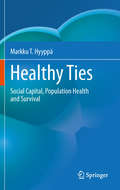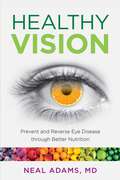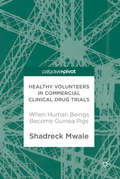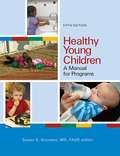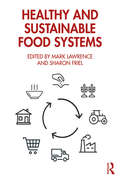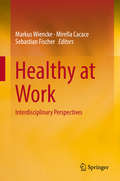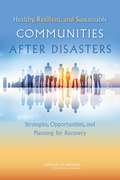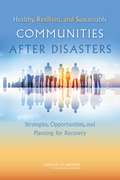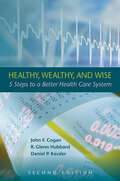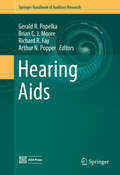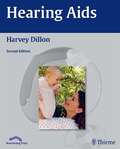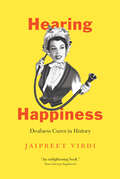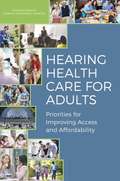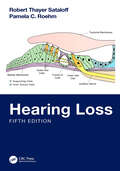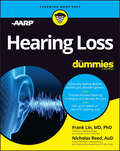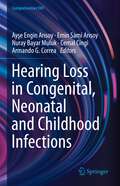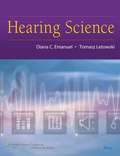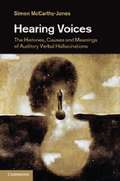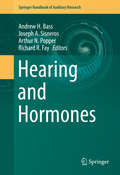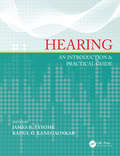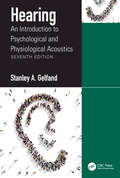- Table View
- List View
Healthy Ties
by Markku T. HyyppäSocial capital is a widely acknowledged candidate for implementing beneficial democratic processes and promoting public health. Healthy ties. Social capital, population health and survival traces the path from the conceptualization to the implementation of social capital. To provide empirical proof of the effects of social capital on public health is a serious challenge and the main focus of the book. In the Nordic countries, personal identification codes linking data from various sources, nation-wide population registers, nationally representative and re-tested health surveys, and the long tradition of epidemiology submit to serve well the research into social capital and public health. Up-to-date longitudinal data on social capital and health outcomes are carefully described and reviewed in this book. In Finland, the Swedish-speaking minority is very long-lived and has better health as compared with the Finnish-speaking majority.
Healthy Vision: Prevent and Reverse Eye Disease through Better Nutrition
by Neal AdamsMore than 180 million Americans have a problem with their vision. Most believe there's not much they can do on their own to change how much (or how little) they see. Now there is hope. In the past decade, an overwhelming number of clinical studies have shown that eating specific nutrients can help maintain vision well into old age, alleviate eye conditions, and even reverse the progress of diseases. In this book, top ophthalmologist Dr. Neal Adams uses clear, accessible language to translate research from hundreds of clinical studies in ophthalmology and nutrition to show how we can restore and maintain eyesight by changing our diet. The solution is simple: just naturally grown foods, with nutrients clinically proven to target the components of the eye affected by disease and/or age. The book explains how the eye functions and what nutrients influence these physiological processes, and includes tailored, easy-to-understand instruction on which foods and nutrients will target the reader's specific concerns. Particularly helpful for the 150 million Americans who visit their eye doctors annually as well as the 95 percent of Americans over 40 at risk for future vision loss.
Healthy Volunteers in Commercial Clinical Drug Trials
by Shadreck MwaleThis book provides a richly detailed contribution to the understanding of healthy volunteer experiences in clinical drug trials in the UK. Contemporary society, especially the West, has seen a significant increase in the production and use of pharmaceutical products, particularly for disease treatment. However, despite the large numbers of people involved, particularly in the UK, very little is known about their experiences in commercial phase I clinical drug trials. Shadreck Mwale critiques common conceptions of the terms 'volunteer' and 'altruism' as used in policy and practice of human involvement in clinical trials and calls for an awareness of the complexity of the terms and how the social contexts participants find themselves in shape acts of voluntarism. Based on extensive empirical evidence and conceptual analysis, the book presents new insights into the lives of healthy volunteers, challenges bioethical conceptions and generates new frameworks for policy and practice of FIHCTs. It will be of particular interest to scholars and practitioners in the wider social sciences, medical Sociology and medical anthropology, pharmacology and bioethics.
Healthy Young Children: A Manual For Programs
by Susan Aronson"Now in its fifth edition, Healthy Young Children has been used in hundreds of early childhood settings to promote the health, nutrition, and safety of children, staff members, and families. This edition contains a new chapter on promoting children's health through physical activity. Also included are updated standards, procedures, and resources, including sample forms, letters, and checklists. This manual is an invaluable resource for program directors, consultants working with early childhood programs, teacher educators, professional development staff, and other concerned about keeping children and adults safe and healthy"
Healthy Young Children: A Manual for Programs
by Susan S. AronsonAs program directors, teachers, students learning to be teachers, or other professionals working with child care facilities, you mush be able to protect and promote the health and well-being of the young children, staff, and families in child care. .
Healthy and Sustainable Food Systems
by Mark Lawrence Sharon FrielThis comprehensive text provides the latest research on key concepts, principles and practices for promoting healthy and sustainable food systems. There are increasing concerns about the impact of food systems on environmental sustainability and, in turn, the impact of environmental sustainability on the capacity of food systems to protect food and nutrition security into the future. The contributors to this book are leading researchers in the causes of and solutions to these challenges. As international experts in their fields, they provide in-depth analyses of the issues and evidence-informed recommendations for future policies and practices. Starting with an overview of ideas about health, sustainability and equity in relation to food systems, Healthy and Sustainable Food Systems examines what constitutes a food system, with chapters on production, manufacturing, distribution and retail, among others. The text explores health and sustainable diets, looking at issues such as overconsumption and waste. The book ends with discussions about the politics, policy, personal behaviours and advocacy behind creating healthy and sustainable food systems. With a food systems approach to health and sustainability identified as a priority area for public health, this text introduces core knowledge for students, academics, practitioners and policy-makers from a range of disciplines including food and nutrition sciences, dietetics, public health, public policy, medicine, health science and environmental science.
Healthy at Home
by Tieraona Low DogGet the how, when, and why of getting better and staying well with homemade remedies that the doctor orders. National Geographic helps you take charge of health care guided by a physician expert in natural healing, herbal medicine, and home remedies. Never have we needed this advice more than now, as worries about hospital-borne infections, antibiotic resistance, and pandemic threats make us yearn for the days of doctor home visits and mother's chicken soup. We need to rediscover the special care and comfort that comes from caring for health at home, says Dr. Low Dog. In this book she guides us in identifying, responding to, and caring for all the most common ailments, so that when it's time to take care at home, you have a doctor's advice on how. Learn how to make herbal remedies and why you and your family will be healthier for doing so--and get advice on when it's best to consult a health care professional instead.
Healthy at Work
by Sebastian Fischer Markus Wiencke Mirella CacaceThis book aims at exploring the link between corporate and organizational culture, public and private policy, leadership and managerial skills or attitudes, and the successful implementation of work-related healthcare in Europe. Therefore it brings together a wide range of empirical and theoretical contributions from occupational health, management, psychology, economics, and (organizational) sociology to address the question of how to sustainably promote occupational health. Such important questions are answered as: What aspects of a corporate culture can be associated with health issues? How does leadership style affect the health of employees? How are health-related decisions in the workplace affected by the political environment? To what extent are interventions influenced by corporate culture, leadership and public policy? How can we make such interventions sustainable?
Healthy, Resilient, and Sustainable Communities After Disasters: Strategies, Opportunities, and Planning for Recovery
by Committee on Post-Disaster Recovery of a Community's Public Health Medical Social ServicesIn the devastation that follows a major disaster, there is a need for multiple sectors to unite and devote new resources to support the rebuilding of infrastructure, the provision of health and social services, the restoration of care delivery systems, and other critical recovery needs. In some cases, billions of dollars from public, private and charitable sources are invested to help communities recover. National rhetoric often characterizes these efforts as a "return to normal. " But for many American communities, pre-disaster conditions are far from optimal. Large segments of the U. S. population suffer from preventable health problems, experience inequitable access to services, and rely on overburdened health systems. A return to pre-event conditions in such cases may be short-sighted given the high costs - both economic and social - of poor health. Instead, it is important to understand that the disaster recovery process offers a series of unique and valuable opportunities to improve on the status quo. Capitalizing on these opportunities can advance the long-term health, resilience, and sustainability of communities - thereby better preparing them for future challenges. "Healthy, Resilient, and Sustainable Communities After Disasters" identifies and recommends recovery practices and novel programs most likely to impact overall community public health and contribute to resiliency for future incidents. This book makes the case that disaster recovery should be guided by a healthy community vision, where health considerations are integrated into all aspects of recovery planning before and after a disaster, and funding streams are leveraged in a coordinated manner and applied to health improvement priorities in order to meet human recovery needs and create healthy built and natural environments. The conceptual framework presented in "Healthy, Resilient, and Sustainable Communities After Disasters" lays the groundwork to achieve this goal and provides operational guidance for multiple sectors involved in community planning and disaster recovery. "Healthy, Resilient, and Sustainable Communities After Disasters" calls for actions at multiple levels to facilitate recovery strategies that optimize community health. With a shared healthy community vision, strategic planning that prioritizes health, and coordinated implementation, disaster recovery can result in a communities that are healthier, more livable places for current and future generations to grow and thrive - communities that are better prepared for future adversities.
Healthy, Resilient, and Sustainable Communities After Disasters: Strategies, Opportunities, and Planning for Recovery
by Medical Social Services Committee on Post-Disaster Recovery of a Community’s Public HealthIn the devastation that follows a major disaster, there is a need for multiple sectors to unite and devote new resources to support the rebuilding of infrastructure, the provision of health and social services, the restoration of care delivery systems, and other critical recovery needs. In some cases, billions of dollars from public, private and charitable sources are invested to help communities recover. National rhetoric often characterizes these efforts as a "return to normal. " But for many American communities, pre-disaster conditions are far from optimal. Large segments of the U. S. population suffer from preventable health problems, experience inequitable access to services, and rely on overburdened health systems. A return to pre-event conditions in such cases may be short-sighted given the high costs - both economic and social - of poor health. Instead, it is important to understand that the disaster recovery process offers a series of unique and valuable opportunities to improve on the status quo. Capitalizing on these opportunities can advance the long-term health, resilience, and sustainability of communities - thereby better preparing them for future challenges. "Healthy, Resilient, and Sustainable Communities After Disasters" identifies and recommends recovery practices and novel programs most likely to impact overall community public health and contribute to resiliency for future incidents. This book makes the case that disaster recovery should be guided by a healthy community vision, where health considerations are integrated into all aspects of recovery planning before and after a disaster, and funding streams are leveraged in a coordinated manner and applied to health improvement priorities in order to meet human recovery needs and create healthy built and natural environments. The conceptual framework presented in "Healthy, Resilient, and Sustainable Communities After Disasters" lays the groundwork to achieve this goal and provides operational guidance for multiple sectors involved in community planning and disaster recovery. "Healthy, Resilient, and Sustainable Communities After Disasters" calls for actions at multiple levels to facilitate recovery strategies that optimize community health. With a shared healthy community vision, strategic planning that prioritizes health, and coordinated implementation, disaster recovery can result in a communities that are healthier, more livable places for current and future generations to grow and thrive - communities that are better prepared for future adversities.
Healthy, Wealthy, and Wise: 5 Steps to a Better Health Care System, Second Edition (Aei Hoover Policy Ser.)
by R. Glenn Hubbard Daniel P. Kessler John F. CoganIn this second edition of their 2005 work, the authors offer market-based alternatives to recent health care reforms that center on tax changes, insurance market changes, and the redesign of Medicare and Medicaid. They show that, by promoting cost- conscious behavior and competition in both private markets and government programs such as Medicare and Medicaid, we can slow the rate of growth of health care costs, expand access to high-quality health care, and slow down runaway spending.
Hearing (Our) Voices
by Barbara SchneiderHearing (Our) Voices describes two innovative participatory action research projects - one on communication with medical professionals, the other on housing - carried out by a group of people diagnosed with schizophrenia under the guidance of Professor Barbara Schneider. Participants designed the research, conducted interviews and focus groups, participated in data analysis, and disseminated research results through a number of innovative strategies including theatre performances, a documentary film, a graphic novel, and a travelling exhibit.Emerging from these projects is the central and significant finding that people diagnosed with schizophrenia are caught between their dependence on care and their longing for independent lives. The research presented in Hearing (Our) Voices points to a way to resolve this paradox and transform lives through the inclusion of people diagnosed with schizophrenia in research, in decision-making about their own treatment and housing, and in public discourse about schizophrenia.
Hearing Aids
by Arthur N. Popper Richard R. Fay Gerald R. Popelka Brian C. J. MooreThis volume will serve as the first Handbook of its kind in the area of hearing aid research, often the least-defined, least-understood, part of the multi-disciplinary research process. Most scientific training is very advanced within the particular disciplines but provides little opportunity for systematic introduction to the issues and obstacles that prevent effective hearing-aid related research. This area has emerged as one of critical importance, as signified by a single specialized meeting (the International Hearing Aid Conference, IHCON) that brings together specialists from the disparate disciplines involved, including both university and industry researchers. Identification of the key steps that enable high-impact basic science to ultimately result in significant clinical advances that improve patient outcome is critical. This volume will provide an overview of current key issues in hearing aid research from the perspective of many different disciplines, not only from the perspective of the key funding agencies, but also from the scientists and clinicians who are currently involved in hearing aid research. It will offer insight into the experience, current technology and future technology that can help improve hearing aids, as scientists and clinicians typically have little or no formal training over the whole range of the individual disciplines that are relevant. The selection and coverage of topics insures that it will have lasting impact, well beyond immediate, short-term, or parochial concerns.
Hearing Aids
by Harvey DillonIt's revised to reflect the research and technological advances of the last decade, New chapters on directional microphones and the latest digital signal processing strategies, coverage of all aspects of open-canal, thin-tube hearing aids, tips, tables, and procedures designed to be pinned on the walls of clinics, each cross-referenced chapter builds on the previous chapters. It has a one-page synopsis that captures the key concepts of each topic. The material that students need is contained in marked paragraphs to form a coherent thin book inside the larger book. Intervening additional paragraphs add satisfying depth.
Hearing Happiness: Deafness Cures in History (Chicago Visions and Revisions)
by Jaipreet VirdiAt the age of four, Jaipreet Virdi’s world went silent. A severe case of meningitis left her alive but deaf, suddenly treated differently by everyone. Her deafness downplayed by society and doctors, she struggled to “pass” as hearing for most of her life. Countless cures, treatments, and technologies led to dead ends. Never quite deaf enough for the Deaf community or quite hearing enough for the “normal” majority, Virdi was stuck in aural limbo for years. It wasn’t until her thirties, exasperated by problems with new digital hearing aids, that she began to actively assert her deafness and reexamine society’s—and her own—perception of life as a deaf person in America. Through lyrical history and personal memoir, Hearing Happiness raises pivotal questions about deafness in American society and the endless quest for a cure. Taking us from the 1860s up to the present, Virdi combs archives and museums in order to understand the long history of curious cures: ear trumpets, violet ray apparatuses, vibrating massagers, electrotherapy machines, airplane diving, bloodletting, skull hammering, and many more. Hundreds of procedures and products have promised grand miracles but always failed to deliver a universal cure—a harmful legacy that is still present in contemporary biomedicine. Weaving Virdi’s own experiences together with her exploration into the fascinating history of deafness cures, Hearing Happiness is a powerful story that America needs to hear.
Hearing Health Care for Adults: Priorities for Improving Access and Affordability
by Engineering Medicine National Academies of SciencesThe loss of hearing - be it gradual or acute, mild or severe, present since birth or acquired in older age - can have significant effects on one's communication abilities, quality of life, social participation, and health. Despite this, many people with hearing loss do not seek or receive hearing health care. The reasons are numerous, complex, and often interconnected. For some, hearing health care is not affordable. For others, the appropriate services are difficult to access, or individuals do not know how or where to access them. Others may not want to deal with the stigma that they and society may associate with needing hearing health care and obtaining that care. Still others do not recognize they need hearing health care, as hearing loss is an invisible health condition that often worsens gradually over time. In the United States, an estimated 30 million individuals (12.7 percent of Americans ages 12 years or older) have hearing loss. Globally, hearing loss has been identified as the fifth leading cause of years lived with disability. Successful hearing health care enables individuals with hearing loss to have the freedom to communicate in their environments in ways that are culturally appropriate and that preserve their dignity and function. Hearing Health Care for Adults focuses on improving the accessibility and affordability of hearing health care for adults of all ages. This study examines the hearing health care system, with a focus on non-surgical technologies and services, and offers recommendations for improving access to, the affordability of, and the quality of hearing health care for adults of all ages.
Hearing Loss
by Robert Thayer Sataloff Pamela C. RoehmCovering all aspects of the anatomy, physiology, diagnosis, and treatment of hearing loss, this is an accessible and comprehensive text for all clinicians interested in expanding their knowledge of hearing loss.There have been many exciting developments in the nearly two decades since the fourth edition was published. This revised edition includes new material on cochlear biology, synaptopathy, regenerative therapy for sensorineural hearing loss, systemic causes of hearing loss such as autoimmune inner ear disease, advances in audiometry and aural rehabilitation, and many other topics. In addition, it contains expanded chapters on tinnitus, dizziness, and facial paralysis, as well as updated material on otoacoustic emissions, sudden hearing loss, hearing protection devices, temporal bone tumors, nutraceutical research, and hearing in dogs. The book is extensively augmented with case reports that illustrate important principles.The book is of value to otolaryngologists, general practitioners, pediatricians, residents, medical students, audiologists, nurses, audiometric technicians, attorneys, and other professionals with an interest in the ear and hearing.
Hearing Loss For Dummies
by Nicholas Reed Frank LinImprove your hearing, enhance your life With new advice on just-released over-the-counter hearing aids Hearing loss can be frustrating, but in fact it&’s common and treatable. Hearing Loss For Dummies, written by top experts in the field in collaboration with AARP, walks you through how to get the help you need to clearly hear the sounds of life—whether you&’re at home, at work, or out and about. And hearing health is critical: Hearing loss can increase your risk of falls and injuries, isolation and depression, and even cognitive decline and dementia. Authors Frank Lin and Nicholas Reed at the Johns Hopkins School of Medicine lay out the steps to hearing health: Understanding how hearing works—and how it changes as we age Finding specialists you can trust Determining whether you need testing and, if so, where to turn Learning practical solutions for hearing better at home, at work, on the phone, and in restaurants and theaters Choosing the right hearing aid, including just-approved over-the-counter hearing aids, and getting them adjusted to work for you Exploring the pros and cons of cochlear implants and other surgical options Covering the costs of hearing health careIf you&’re concerned about your own or a friend or relative&’s hearing, this is the one book you&’ll need. For what can seem like a complicated, stressful and lengthy process, Hearing Loss For Dummies tackles the topic head-on and provides you with expert guidance to put your mind at ease on the path to better hearing.
Hearing Loss and Healthy Aging: Workshop Summary
by Tracy A. LustigBeing able to communicate is a cornerstone of healthy aging. People need to make themselves understood and to understand others to remain cognitively and socially engaged with families, friends, and other individuals. When they are unable to communicate, people with hearing impairments can become socially isolated, and social isolation can be an important driver of morbidity and mortality in older adults. Despite the critical importance of communication, many older adults have hearing loss that interferes with their social interactions and enjoyment of life. People may turn up the volume on their televisions or stereos, miss words in a conversation, go to fewer public places where it is difficult to hear, or worry about missing an alarm or notification. In other cases, hearing loss is much more severe, and people may retreat into a hard-to-reach shell. Yet fewer than one in seven older Americans with hearing loss use hearing aids, despite rapidly advancing technologies and innovative approaches to hearing health care. In addition, there may not be an adequate number of professionals trained to address the growing need for hearing health care for older adults. Further, Medicare does not cover routine hearing exams, hearing aids, or exams for fitting hearing aids, which can be prohibitively expensive for many older adults. "Hearing Loss and Healthy Aging" is the summary of a workshop convened by the Forum on Aging, Disability, and Independence in January 2014 on age-related hearing loss. Researchers, advocates, policy makers, entrepreneurs, regulators, and others discussed this pressing social and public health issue. This report examines the ways in which age-related hearing loss affects healthy aging, and how the spectrum of public and private stakeholders can work together to address hearing loss in older adults as a public health issue.
Hearing Loss in Congenital, Neonatal and Childhood Infections (Comprehensive ENT)
by Cemal Cingi Nuray Bayar Muluk Armando G. Correa Emin Sami Arısoy Ayşe Engin ArısoyThis book provides a broader understanding of infectious diseases and hearing loss prevention and treatment in children. In addition to all the common infections, the book covers the prion diseases, the autoinflammatory syndromes, and diseases of unknown etiology. A specific chapter is dedicated to cochlear implant infections. The final part reviews the available therapeutic agents. Written by international experts, the book will appeal to a wide readership, from ENT and pediatrics trainees, to practitioners and researchers in these disciplines.
Hearing Science
by Tomasz Letowski Diana C. EmanuelThis textbook provides a comprehensive presentation of all aspects of hearing science, including acoustics, psychoacoustics, anatomy and physiology, and related topics such as introduction to digital signal processing and instrumentation in hearing science. It is designed to supplement in-class instruction with both remedial and advanced material for students with different academic backgrounds, and is ideally suited for speech pathology and audiology students at the undergraduate and introductory graduate levels.
Hearing Voices
by Simon Mccarthy-Jones"The meanings and causes of hearing voices that others cannot hear (auditory verbal hallucinations, in psychiatric parlance) have been debated for thousands of years. Voice-hearing has been both revered and condemned, understood as a symptom of disease as well as a source of otherworldly communication. Those hearing voices have been viewed as mystics, potential psychiatric patients or simply just people with unusual experiences, and have been beatified, esteemed or accepted, as well as drugged, burnt or gassed. This book travels from voice-hearing in the ancient world through to contemporary experience, examining how power, politics, gender, medicine and religion have shaped the meaning of hearing voices. Who hears voices today, what these voices are like and their potential impact are comprehensively examined. Cutting edge neuroscience is integrated with current psychological theories to consider what may cause voices and the future of research in voice-hearing is explored"--Provided by publisher.
Hearing and Hormones
by Arthur N. Popper Richard R. Fay Andrew H. Bass Joseph A. SisnerosThis book reviews the growing literature that is consistent with the hypothesis that hormones can regulate auditory physiology and perception across a broad range of animal taxa, including humans. Understanding how hormones modulate auditory function has far reaching implications for advancing our knowledge in the basic biomedical sciences and in understanding the evolution of acoustic communication systems. A fundamental goal of neuroscience is to understand how hormones modulate neural circuits and behavior. For example, steroids such as estrogens and androgens are well-known regulators of vocal motor behaviors used during social acoustic communication. Recent studies have shown that these same hormones can also greatly influence the reception of social acoustic signals, leading to the more efficient exchange of acoustic information.
Hearing: An Introduction & Practical Guide
by James Tysome Rahul KanegaonkarHearing is essential for normal communication. We are able to localise sound with surprising accuracy and can detect time differences as small as the time it takes for sound to pass from the mouth of one person to the ear of another. However, hearing loss is underdiagnosed, poorly understood and a common cause of social isolation. <P><P>Hearing: An Introduction and Practical Guide provides a basic understanding of the science of hearing, the causes of hearing loss and how hearing loss can be clinically assessed and effectively treated. The book is divided into three sections, beginning with a review of the basic anatomy, physiology and principles of hearing. The second section addresses clinical and audiological assessment of hearing as well as imaging of the ear. The third section features an extensive series of chapters on focused topics covering the range of causes of hearing loss, their management and options for hearing rehabilitation. <P><P> Clear, concise and comprehensive, Hearing: An Introduction and Practical Guide is an excellent source of information for ENT surgeons, general practitioners and trainees. It presents a quick reference and practical guide for assessing and managing patients with hearing loss.
Hearing: An Introduction to Psychological and Physiological Acoustics
by Stanley A. GelfandThis fully revised and updated seventh edition provides a thorough overview and introduction to hearing science. Covering topics such as conductive and cochlear mechanisms, auditory pathways, and binaural and spatial hearing and including some new and updated diagrams and figures, this book serves as a great resource for both graduate students and professionals working in audiology and other fields like psychology, neuroscience, otolaryngology, and linguistics. This improved edition reflects the ever-changing field of hearing science.
